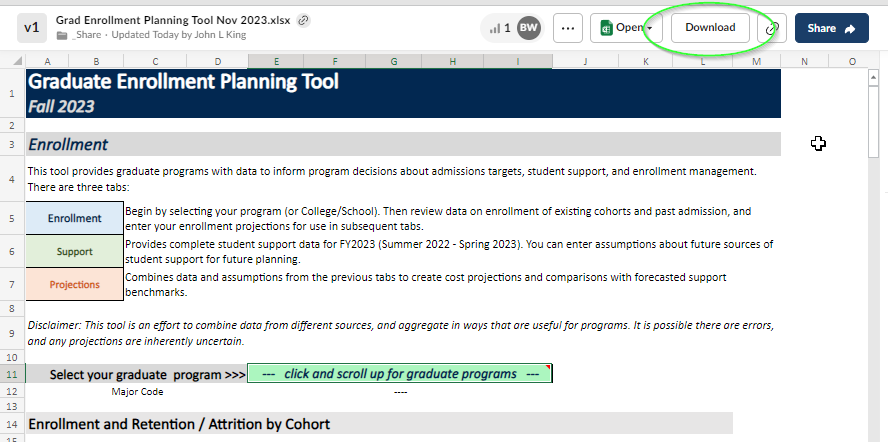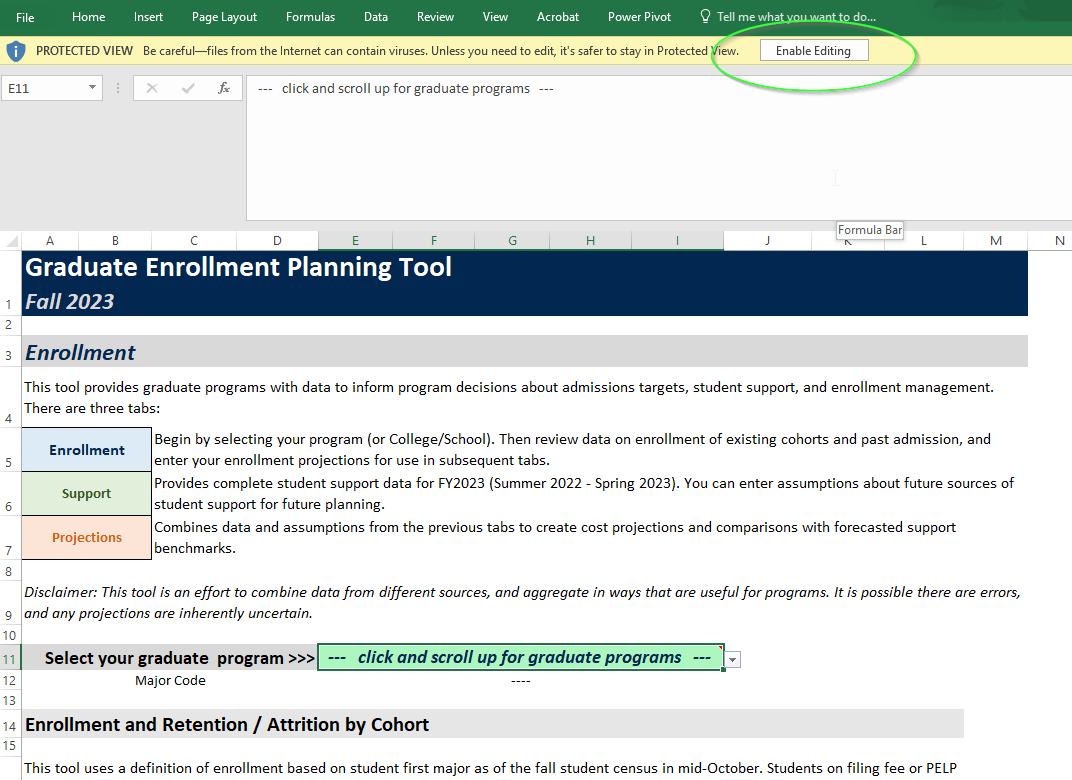Graduate Enrollment Planning Tool
The Graduate Enrollment Planning Tool was developed to address the need for programs to project enrollment and student support costs. It provides a structured approach to decision making and resource allocation, helping programs optimize their planning strategies.
Once downloaded (see button below), this tool enables users to model different scenarios and assess the implications for multi-year planning. By inputting various enrollment and support parameters, programs can gain insights into the potential outcomes and make informed decisions.
This tool offers a user-friendly interface with three tabs dedicated to different aspects of the planning process.
- Enrollment: review data on enrollment of existing cohorts and past admission, and enter your enrollment projections for use in subsequent tabs.
- Support: provides complete student support data for FY2023 (Summer 2022 - Spring 2023). You can enter assumptions about future sources of student support for future planning.
- Projections: combines data and assumptions from the previous tabs to create cost projections and comparisons with forecasted support benchmarks.
Download the Graduate Enrollment Planning Tool
Frequently Asked Questions
- I tried to edit the Graduate Enrollment Planning Tool in Box, but it wouldn't work. What should I do?
- You need to download the Graduate Enrollment Planning Tool from Box. It is not editable in Box preview mode.

- I downloaded the Graduate Enrollment Planning Tool from Box, but when I open it in Excel, I can't edit it. What should I do?
- Once downloaded, you can open the Graduate Enrollment Planning Tool in Excel and click "Enable Editing" at the top of the screen in order to use it.

- How do I interpret the graph on the "Projections" tab?
-
The circles represent average student program support in 2022-23. The lines represent different per-student benchmarks described in the table below: tuition and fees only; 9 months of support at a 50% TA/GSR appointment (orange lines); or 12 months of support at a 50% TA/GSR appointment (blue lines). Solid lines show the benchmarks including NRST, dotted lines without NRST. The upward slope of the lines shows the increased costs of supporting students at the same benchmark.
-
Do my enrollment numbers include students on PELP, Filing Fee, etc?
-
Enrollment includes registered students in active status as of the fall census. That excludes students on PELP or Filing Fee, and includes part-time students and students on In Absentia status.
-
How does the data count students pursuing both a Master’s and a Ph.D.?
-
Students are counted by their first major and degree objective. For students pursuing both a Ph.D. and a master's degree, that is almost always the Ph.D.
-
Can I use this tool to project future TA budgets or fellowship allocations?
- This tool uses enrollment projections to estimate future student support costs. It is beyond the scope of the tool to predict instructional budgets, availability of extramural funding, or many other factors that go into enrollment planning. We hope that the tool provides as much information as possible to inform planning discussions within your program.
- Is the TA support shown calculated by department or by student?
- TA/AI support is aggregated according to the students who receive it and the program they are enrolled in, not by the hiring department or course.
-
What if my graduate program is not listed?
-
The tool is focused on enrollment planning for state-supported graduate programs. Self-supporting graduate professional degree programs (SSGPDP), programs that charge professional degree supplemental tuition (PDST), and certain post-baccalaureate programs (credentials and graduate academic certificates) are not included.
